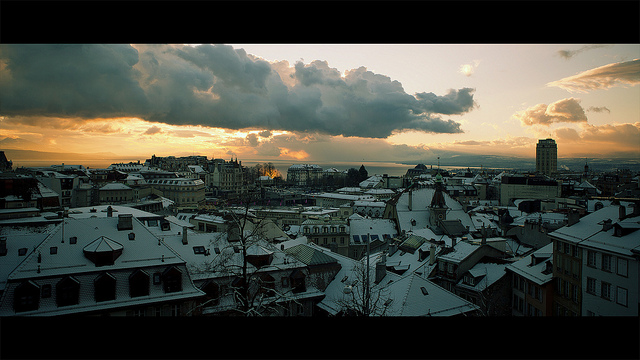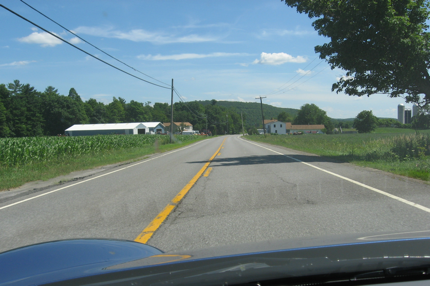
The BBF is New England’s largest annual literary event, boasting a bustling street fair, workshops for aspiring authors, an outdoor music stage, and more! For more information on this year’s event, see www.bostonbookfest.org

The BBF is New England’s largest annual literary event, boasting a bustling street fair, workshops for aspiring authors, an outdoor music stage, and more! For more information on this year’s event, see www.bostonbookfest.org

Our grey Swiss building has ceiling moldings in the shape of flowers. These were white once. Before we immigrants took over most of its floors. The only natives who remain are very old. They have no children or pensions large enough to help them flee our foreign invasion. Like Madame Belet, who lives one floor down from us and gives me old, melted chocolates when I run errands for her.
Book by SMITH HENDERSON
Reviewed by

Number two on Kurt Vonnegut’s famous eight-item to-do list for fiction writers is: “Give the reader at least one character he or she can root for.” But not too much, one might add. Smith Henderson strikes the balance between likeable and unlikeable admirably in the protagonist of his debut novel Fourth of July Creek. Set in rural Montana, the novel follows Pete Snow, a social worker who rescues children from abusive and dysfunctional families. We like Pete. He gets kids out of dangerous houses with drug-dealing parents, as seen in the novel’s opening scene in which Pete responds to a domestic dispute between one of his clients, teenage Cecil, and his speed-addicted mother—Cecil’s on the roof of the house, Mom’s shooting at him with a pellet gun.Pete knows that this is noble work without being self-righteous about it. He’s funny. When the officer tells Pete that Cecil knocked himself out running into the tailgate of a pickup truck, Pete’s sole response is, “I imagine that was satisfying.” But as the novel progress, we begin to dislike him, too. He slugs Cecil in the stomach. He admits to alcoholism but does nothing about it. We’re not talking about quiet tippling here. He drinks himself into violence, punching out his own car windows on one occasion, then blacks out. He can be a bit of a misogynist.

We were staying on the Upper West Side, 15th floor, view of the Hudson. Two hawks nested on the fire escape outside our bedroom window, their baby hawk’s head popping out of its shell. The male was wary. Very. One day, X ray vision on, he stormed the window from afar, a bolt from the blue looming larger, nearer, yeeks! Shot skywards just shy of crashing into the window.
The ending place is empty—nearly. I am writing this in the beginning place because it seems not quite right to start in a place that is ending.
On the phone, completing the last of the cleaning, he describes to me the ending place. He is there and I am here. He describes the span of those walls (now spackled) in which we made our lives these past eight years. Walls from which we hung postcards and pictures, pieces of metal and lace, the mirrored shadowbox, the plaster cherub, all the instruments. There, where the doors were painted a sloppy garish teal long before our arrival, where the ‘beautiful hardwood floors’ finally gave up, splintered into thick spears. The EIK, table now gone, in which innumerable parties dwindled to their inevitable but elusive ends, linoleum peeling along its edge. But I am here, 100 miles west, two days in: surrounded by countless boxes, all the stuff, the anxious cats—on the cusp of the new, an expansive place—beginning.
Please enjoy these new poems by five new contributors to The Common.
Introduction by SCOTT GEIGER, photos by JAMES EWING.

A couple years ago, on the verge of the global collapse, structural engineer Guy Nordenson did an interview with me for a literary monthly, The Believer. The magazine’s title quote ran, “The tall building, as a type, is exhausted.” You could no longer put together a tall office building or a mixed-use tower in a new way, Nordenson felt. World Trade Center Tower One or maybe the CCTV Building in Beijing, depending on your architectural orientation, closed out the skyscraper play, at least in terms of engineering and architectural innovation.
These last two years, though, exotic forces in global finance have conspired to construct in the Manhattan street grid a radically new tall building typology. The super towers, or “billionaires’ beanstalks,” as New York Magazine’s architecture critic Justin Davidson described them, are stacks of full-floor loft apartments (sometimes duplexes) rising into the blue. The forthcoming 111 West 57th Tower, featured on its architect’s website, shows the sheer building arising from a tiny claw hold in Manhattan.
To realize such super towers, their developers and architects have to delicately escort them through New York City municipal agencies and community boards. They must also sell the apartment units, often to prospective owners who do not live in New York City or even in the United States. Architectural renderings do this work. These are digital collages of one or more real photographs, upon which is imposed a scintillating computer-generated image produced from three-dimensional architectural design software. There are whole design agencies, like rendering pioneers DBOX, who specialize solely in the production of these very high-resolution illusions for use in real estate marketing.
Over the summer I learned that Brooklyn architectural photographer James Ewing has regular commissions to document the urban fabric surrounding Manhattan commercial developments. He sometimes even photographs the open airspace around future super towers. To make such images, Ewing accessed the terraces and mechanical rooms of neighboring high-rise towers, waiting long hours for the weather to clear, the daylight or the darkness to settle just so. After studying architectural renderings for a few years now, I’ve concluded that their appeal comes not from their dazzling subjects but from the everyday real upon which the proposed architecture trespasses.
Ewing shot the images below to serve as backgrounds to architectural renderings, which will tease out a counterlife to the city. A knowing consciousness animates the photographs, I feel. His views frame a cumulative, sculptural Manhattan. No sign of street life. Instead, this subjectivity sees a geometric landscape of facades and windowwalls—each building nothing so exotic or radical as the crystallization of market forces past. Especially dramatic to see is the form of the cumulative city juxtaposed to the Hudson and East Rivers at its edge. To the subjectivity within these images, super towers feel only inevitable, the next phase in New York City’s continuous and speculative growth under the sky.
—Scott Geiger





Scott Geiger is the Architecture Editor for The Common.
Photographs by James Ewing.

By GEOFF KRONIK

East, west, and south, hardwood forests upholster hills named for their compass points, while to the north shines Cayuga, one of the Finger Lakes’ eleven glacial furrows. This is Ithaca, where, as it was when I grew up here forty years ago, the nearest Interstate is still thirty miles away. The aesthetic of those miles is rolling, agricultural, and often hardscrabble, with pro-fracking and “for sale” signs equally likely to appear on roadside barns. To drive to Ithaca is a commitment to the scenic route, metaphorically and visually, because there is neither a fast lane nor an unattractive one.

(Attention: Spoilers Ahead!)
In Fargo, an unpredictable and manipulative out-of-towner named Lorne Malvo (Billy Bob Thornton) incites a string of murders in small-town Minnesota. Though thematically, tonally, and aesthetically based on the critically acclaimed 1996 Coen brothers’ film of the same name – fear not, the series preserves the film’s beloved dark humor and “you betcha”s – the Emmy-nominated FX mini-series introduces entirely new characters and plot. Many of these characters are unexpectedly layered, defying tropes of the idiot detective and the ruthless killer, while some minor characters fit comfortably in well-known molds. It is a credit to the expert writing and acting that even these characters – including Glenn Howerton’s artificially bronzed and tragically naïve personal trainer – are vibrant.
In the first episode, we meet life insurance salesman Lester Nygaard (Martin Freeman) – a doormat tread on by everyone, especially his wife. A chance encounter with his high school bully, Sam Hess (Kevin O’Grady), sends Lester to the hospital with a broken nose. There, he meets Malvo, a hitman with a severe haircut and black eyes, who chides Lester for quietly enduring emasculation and offers to kill Hess. Lester doesn’t say yes to the offer but doesn’t say no either, and the two part ways. Malvo stabs Hess at a strip club that evening. A few days later, a newly confident Lester strikes his wife dead with a hammer when she criticizes him. In a state of panic, Lester calls Malvo to help him deal with the body. First to arrive at Lester’s door, however, is Chief Vern Thurman (Shawn Doyle), there to question Lester about the Hess murder. When Malvo appears, he kills the chief with a shotgun. To avoid suspicion, Lester runs headfirst into a wall to knock himself out as if he too were a victim of whomever committed the other two murders.
Throughout the series, Lester must shed layers of scruples in order to evade capture and preserve his new alpha male persona. This transformation, guided by Malvo’s powerful influence, is the series’ thematic backbone, spawning ethical questions that haunt characters and viewers alike. From the beginning, Lester’s crimes are suspected by the pensive Deputy Molly Solverson (Allison Tolman), and she butts heads against the newly appointed chief. Luckily for Molly, she has Duluth Deputy Gus Grimly (Colin Hanks) on her side – eventually romantically, as well as in the line of duty. Thrown into the mix are the surly, bearded Mr. Numbers (Adam Goldberg) and the hulking, deaf Mr. Wrench (Russell Harvard), who have been hired by Minnesota’s Fargo-based organized crime organization – referred to as “Fargo” – to identify and kill the murderer of Sam Hess. This makes for a complicated game of cat-and-mouse where everyone takes turns as predator and prey.
The show is notable for its skilled acting, striking cinematography, and sharp dialogue that amuse and unsettle viewers. Fargo isn’t perfect – there’s an entire subplot that disappears without resolution or explanation – but the show is confident in a way that lends it a cinematic quality. Even though writer and creator Noah Hawley has described Fargo as a ten-hour movie, there are still ten distinct episodes – each named after a riddle or paradox – which allows for ten beginnings and ten endings. Knowing that our memories give preferential treatment to endings – whether it’s the last thing you read before bed or the final moment of an important relationship – the creators of Fargo have imbued the final scene of each episode with vivid thematic commentary on who comes out on top when some humans behave like beasts.
The last scene of the first episode – “The Crocodile’s Dilemma,” in which Malvo brings corruption to Bemidji – is of Molly and her father Lou, a former policeman, as they prepare to go ice fishing. Lou asks Molly to work as a hostess at his diner, since “people in this world are less inclined to shoot a hostess than, say, an officer of the law.” He’s not surprised, though, when Molly concedes that hers is a risky profession but she’s going to continue on with it anyway. The pair exchange “I love you”s, and Molly walks away, back to work. This scene is a warm blanket that comforts the viewer after an otherwise chilling first episode, providing hope that goodness will be restored and establishing Molly as true north on Fargo’s moral compass.
However, the next two endings, the final scenes of “The Rooster Prince” and “A Muddy Road,” provide no such comfort. Episode 2 ends with Mr. Numbers and Mr. Wrench dragging an innocent man across a frozen lake and lowering him head-first through a hole in the ice. While they ignore the man’s protests, the following lines from Eden Ahbez’s “Full Moon” are spoken in the background:
And in the evening
When the sky is on fire
Heaven and earth become my great open cathedral
Where all men are brother
Where all things are bound by law
And crowned with love
The scene is at once playful and eerie, presenting an auditory representation of utopia simultaneously with visuals representing extraordinary brutality.
The ending of Episode 3 showcases one Malvo’s techniques for destroying his hits. A sweating, pill-crunching supermarket magnate named Stavros (Oliver Platt) steps into a shower, over which scene, Malvo narrates the story of Moses, starting with his rescue from the Nile. When he reads the part where Moses kills an Egyptian man for brutalizing a fellow Jew, blood gushes out of the showerhead onto a horrified Stavros. Then, Malvo appears onscreen, smirking as he walks away from Stavros’s house and pulls a blanket over jugs of pigs’ blood in the trunk of his car. Clearly, Malvo is not a cookie-cutter bounty hunter – he enjoys subjecting his victims to theatric emotional manipulation.
After these endings, the viewer understands the extent to which darkness has infiltrated the world of Fargo and is alarmed by its atrocities. With these elements in place, Episodes 4–10 center on whether Lester will be punished for his actions, by Fargo, the police, or Malvo.
The final scenes of Episodes 4 and 5 emphasize Lester’s trouble. “Eating the Blame” ends with a simple moment of tragic comedy. In his desperation to escape Mr. Numbers and Mr. Wrench, Lester has punched a cop and sits in a holding cell. He is then joined by his pursuers, who tower over him and smile. In the next episode, Lester is hospitalized for a pernicious infection from the shotgun pellet lodged in his hand when Malvo shot the police chief in Lester’s living room. The episode ends as Molly opens the door to his hospital room and glares at Lester’s body, curled up in the fetal position and feigning sleep. This scene depicts two types of hunters, set apart by what motivates them. The predator, Lester, is driven by self-preservation, but the evolved hunter, Molly, is driven by empathy – she’s consumed by the need to right the wrong of her beloved mentor’s murder. Perhaps, according to this scene, the evolved hunter’s motivation gives her a strategic advantage and Lester will finally get his comeuppance.
However, Lester goes on the offensive in the next episode, “Buridan’s Ass,” and plants evidence implicating his brother Chaz (Joshua Close) in the murders of Lester’s wife and the Chief. The ending of this and the next episode (“Who Shaves the Barber?”) depict Lester’s and Molly’s reactions to the success of Lester’s plan – delight and panic, respectively. Here, crime is not met with justice, and these endings are the lowest point of the series’ moral crisis.
In the middle of Episode 8, “The Heap,” Fargo flashes forward a year. Lester is married to the beautiful, adoring Linda (Susan Park), owns Nygaard insurance, and accepts a Salesman-of-the-Year award with marked swagger. But will Lester really get away with it? In the episode’s closing scene, Lester’s security unravels when he spots a lighter-haired but unmistakable Lorne Malvo laughing at a hotel bar in Kansas City.
In the penultimate episode, “A Fox, a Rabbit and a Cabbage,” we find out that Malvo has been posing as a dentist for his next bounty. When Lester insists he knows Malvo, threatening to blow his cover, Lester opens the door for violence to reenter his life. He crosses his former mentor and sacrifices his new wife’s life to escape Malvo’s retribution, and it’s left to Fargo’s final episode, “Morton’s Fork,” to settle who comes out on top. Malvo and Lester die like animals – Malvo at the hand of policeman Gus Grimly, and Lester by falling through thin ice in a desperate escape from the authorities. The show ends with Gus, his daughter Greta (Joey King), and a pregnant Molly cozying up on a couch and watching TV. The timid Gus, now a mailman, has earned a citation for bravery, and Molly gets to be the chief of police.
The endings of each Fargo episode are skillful boiling points: they reach a level of dramatic intensity powerful enough to make a thematic statement, but stylistically quiet enough to avoid being gratuitous. Like that of the first episode, the ending of the finale is a warm, reassuring blanket. Though some might complain that letting the good guys triumph so wholly is a sentimental cop-out, in fact this resolution manages to be both satisfying and unconventional. The threat of Malvo – and his disciple, Lester – are defended by a nervous mailman and his pregnant, milkshake-loving wife. These two, apparently meek but surprisingly strong, are the ultimate top dogs. Their self-sacrifice, empathy, bravery, and neighborliness are realistically and entertainingly under siege in the series’ ten episodes – sometimes finishing with humor, sometimes with horror, but always distinctively Fargo.
Elizabeth Mutter lives in Amherst, MA.